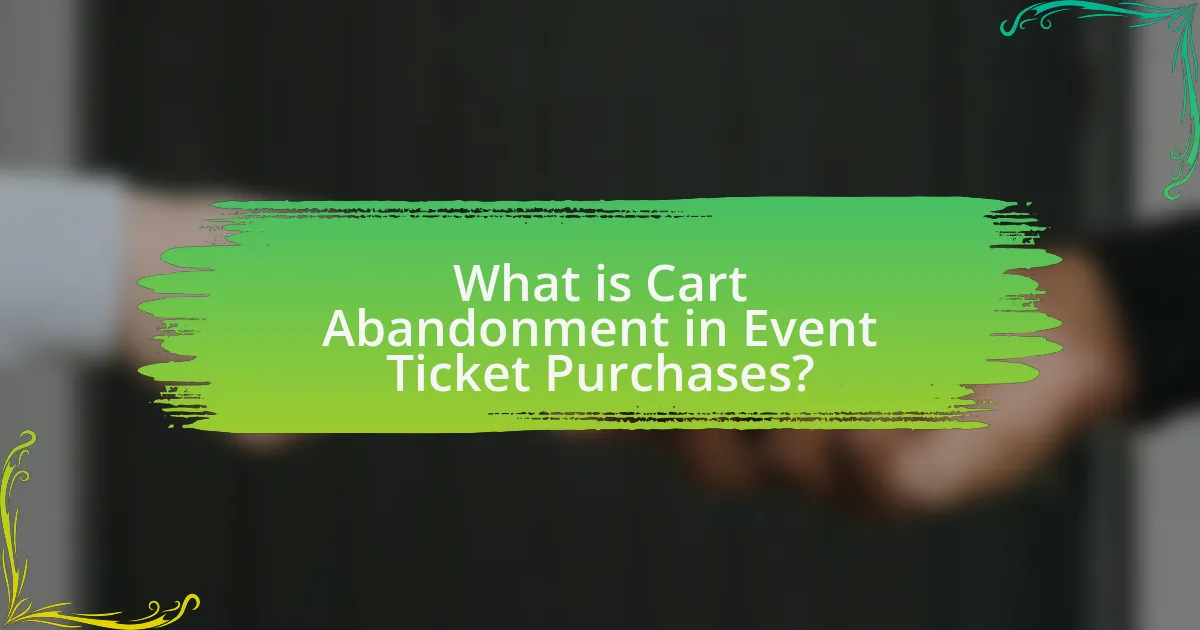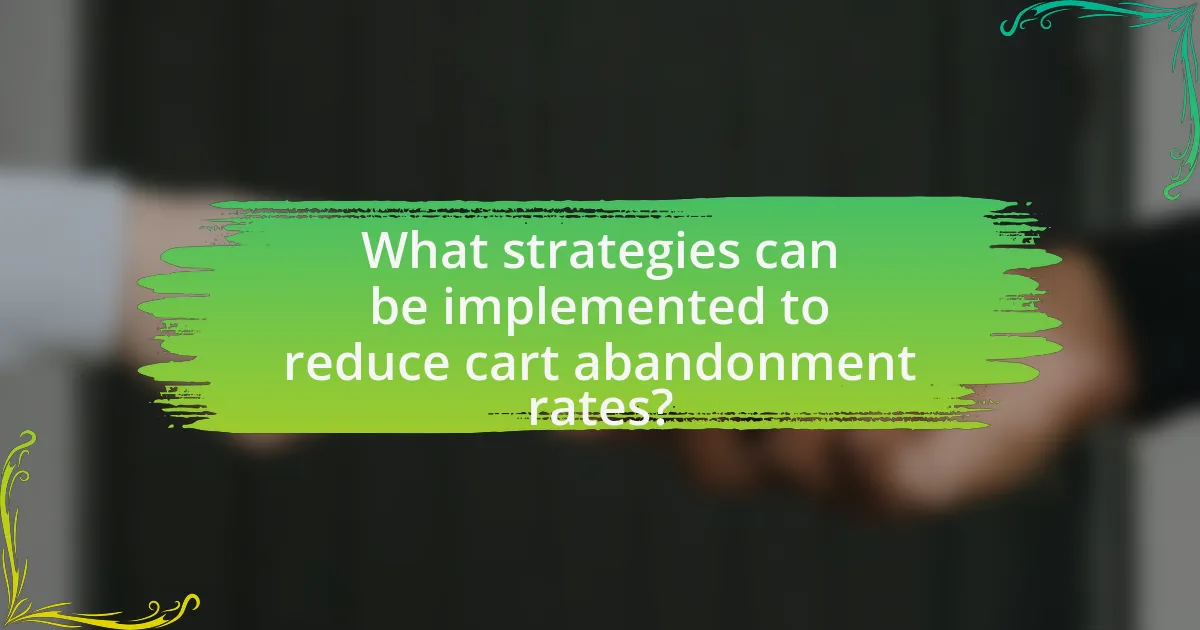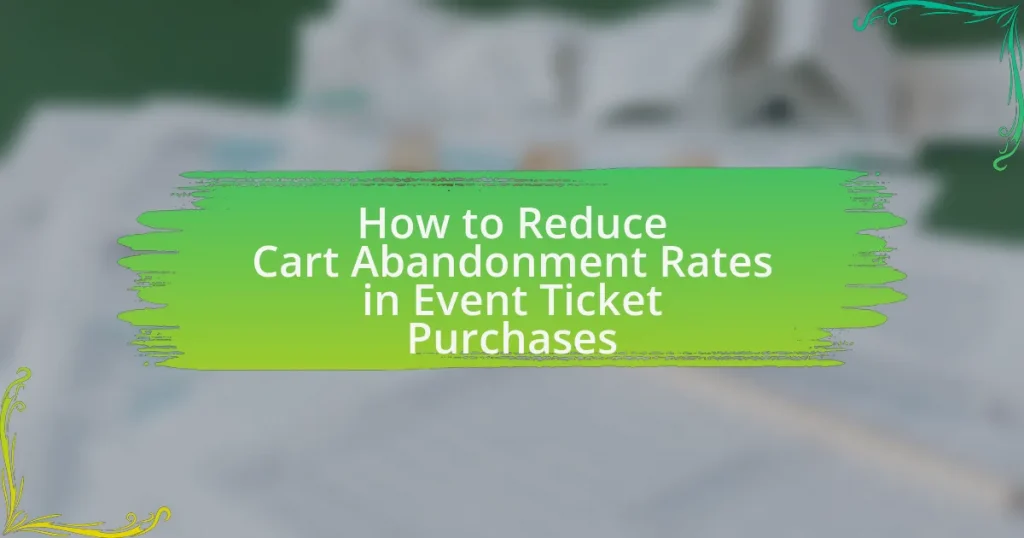Cart abandonment in event ticket purchases is a prevalent issue where potential buyers add tickets to their online carts but do not complete the transaction, with abandonment rates exceeding 70%. This article examines the causes of cart abandonment, including high fees, complicated checkout processes, and limited payment options, and emphasizes the importance of user experience and website design in mitigating this problem. It outlines effective strategies for reducing abandonment rates, such as simplifying the checkout process, enhancing mobile optimization, and utilizing follow-up communication. Additionally, the article discusses the financial impacts of cart abandonment on event organizers and offers best practices for monitoring and analyzing abandonment trends to improve conversion rates.
What is Cart Abandonment in Event Ticket Purchases?

Cart abandonment in event ticket purchases refers to the phenomenon where potential buyers add tickets to their online shopping cart but fail to complete the transaction. This behavior is significant, as studies indicate that approximately 70% of online shopping carts are abandoned, with various factors such as high shipping costs, complicated checkout processes, and unexpected fees contributing to this trend. Understanding cart abandonment is crucial for event organizers and ticket sellers, as it directly impacts revenue and customer engagement.
How does cart abandonment occur during the ticket purchasing process?
Cart abandonment during the ticket purchasing process occurs when potential buyers add tickets to their online shopping cart but fail to complete the transaction. This phenomenon can happen due to various factors, including unexpected costs such as high service fees, complicated checkout processes, or the need for account creation before purchase. Research indicates that approximately 69.57% of online shopping carts are abandoned, with ticket purchases being particularly susceptible due to time-sensitive decisions and competing distractions.
What are the common reasons for cart abandonment in event ticket sales?
Common reasons for cart abandonment in event ticket sales include high additional fees, complicated checkout processes, and lack of payment options. High additional fees, such as service charges or taxes, can deter customers when the final price exceeds their expectations. Complicated checkout processes, which may require excessive information or multiple steps, can frustrate users and lead them to abandon their carts. Additionally, a lack of diverse payment options can limit customers’ ability to complete their purchases, as 56% of consumers abandon carts due to limited payment methods. These factors collectively contribute to significant cart abandonment rates in the event ticket sales industry.
How do user experience and website design impact cart abandonment rates?
User experience and website design significantly impact cart abandonment rates by influencing how easily customers can navigate the purchasing process. A well-designed website with intuitive navigation, fast loading times, and clear calls to action can reduce friction, making it easier for users to complete their purchases. According to a study by Baymard Institute, poor usability is a leading cause of cart abandonment, with 27% of users citing that they found the checkout process too complicated. Additionally, aesthetically pleasing designs that instill trust can enhance user confidence, further decreasing abandonment rates.
Why is reducing cart abandonment important for event ticket sales?
Reducing cart abandonment is crucial for event ticket sales because it directly impacts revenue and profitability. High cart abandonment rates indicate potential lost sales opportunities; for instance, studies show that the average cart abandonment rate for online ticket sales can exceed 70%. By minimizing this rate, event organizers can significantly increase their conversion rates, leading to higher ticket sales and improved financial outcomes. Additionally, addressing the reasons behind cart abandonment, such as complicated checkout processes or unexpected fees, can enhance customer satisfaction and loyalty, further driving future sales.
What financial impacts does cart abandonment have on event organizers?
Cart abandonment significantly impacts event organizers by leading to lost revenue opportunities. When potential attendees leave the purchasing process without completing their ticket transactions, event organizers miss out on sales that could have contributed to their overall budget and profitability. Research indicates that the average cart abandonment rate for online ticket sales can exceed 70%, meaning a substantial portion of potential revenue is forfeited. For instance, if an event has 1,000 visitors to its ticketing page and 700 abandon their carts, the organizer could lose thousands of dollars in ticket sales, directly affecting their financial viability and ability to fund future events.
How does cart abandonment affect customer loyalty and brand reputation?
Cart abandonment negatively impacts customer loyalty and brand reputation by creating a perception of inefficiency and unreliability. When customers leave items in their cart without completing a purchase, it often indicates frustration with the purchasing process, which can lead to decreased trust in the brand. Research shows that 69.57% of online shopping carts are abandoned, highlighting a significant gap in customer engagement. This high abandonment rate can result in customers associating the brand with a lack of user-friendliness, ultimately diminishing their likelihood of returning for future purchases. Additionally, if customers frequently experience cart abandonment, they may share their negative experiences, further harming the brand’s reputation through word-of-mouth and online reviews.
What strategies can be implemented to reduce cart abandonment rates?

To reduce cart abandonment rates in event ticket purchases, implementing strategies such as simplifying the checkout process, offering multiple payment options, and sending follow-up reminders can be effective. Simplifying the checkout process minimizes friction, as studies show that 27% of users abandon carts due to a complicated checkout. Providing multiple payment options caters to diverse customer preferences, which can increase conversion rates. Additionally, sending follow-up reminders, such as emails or notifications, can re-engage customers who left items in their cart, with research indicating that reminder emails can recover up to 10% of abandoned carts.
How can improving website usability decrease cart abandonment?
Improving website usability can significantly decrease cart abandonment by creating a smoother and more intuitive shopping experience for users. When a website is easy to navigate, customers can find products quickly, understand the purchasing process, and complete transactions without frustration. Research indicates that 70% of online shoppers abandon their carts due to complicated checkout processes or difficulty in finding information. By streamlining navigation, simplifying forms, and ensuring mobile compatibility, businesses can enhance user satisfaction, leading to higher conversion rates and reduced cart abandonment.
What specific design elements enhance the user experience during ticket purchases?
Specific design elements that enhance the user experience during ticket purchases include a streamlined checkout process, clear visual hierarchy, and responsive design. A streamlined checkout process minimizes the number of steps required to complete a purchase, reducing friction and the likelihood of cart abandonment. Clear visual hierarchy ensures that important information, such as pricing and event details, is easily accessible and understandable, guiding users through their decision-making. Responsive design allows the ticket purchasing interface to adapt seamlessly across devices, catering to users on mobile, tablet, or desktop, which is crucial as mobile transactions account for a significant portion of online ticket sales. These elements collectively contribute to a more efficient and user-friendly purchasing experience, ultimately leading to higher conversion rates.
How can mobile optimization play a role in reducing cart abandonment?
Mobile optimization significantly reduces cart abandonment by enhancing user experience on mobile devices. A seamless mobile experience, including fast loading times, easy navigation, and simplified checkout processes, directly addresses common pain points that lead to cart abandonment. Research indicates that 70% of mobile users abandon their carts due to poor mobile experiences, highlighting the importance of mobile optimization in retaining potential buyers. By ensuring that websites are responsive and user-friendly, businesses can effectively decrease abandonment rates and increase conversion rates in event ticket purchases.
What role does communication play in minimizing cart abandonment?
Communication plays a critical role in minimizing cart abandonment by addressing customer concerns and enhancing their purchasing experience. Effective communication strategies, such as personalized follow-up emails, real-time chat support, and clear messaging about shipping costs or return policies, can significantly reduce uncertainty and hesitation during the checkout process. Research indicates that 69.57% of online shopping carts are abandoned, often due to lack of information or support. By proactively engaging customers through targeted communication, businesses can clarify doubts, provide reassurance, and ultimately encourage completion of the purchase.
How can follow-up emails encourage users to complete their purchases?
Follow-up emails can encourage users to complete their purchases by reminding them of the items left in their cart and creating a sense of urgency. These emails often include personalized content, such as the specific event tickets the user showed interest in, which reinforces their initial intent to buy. According to a study by the Baymard Institute, 69.57% of online shopping carts are abandoned, and targeted follow-up emails can recover a significant portion of these lost sales by prompting users with incentives like discounts or limited-time offers. This strategy effectively addresses the reasons for cart abandonment, such as distraction or indecision, by providing a clear call to action and reinforcing the value of the purchase.
What messaging strategies can be used to reassure customers during checkout?
Messaging strategies that can be used to reassure customers during checkout include clear communication of security measures, displaying trust signals, and providing real-time support. Clear communication of security measures, such as SSL certificates and secure payment options, helps customers feel safe about their transactions. Trust signals, like recognizable payment logos and customer reviews, enhance credibility and reduce anxiety. Additionally, offering real-time support through chatbots or customer service representatives allows customers to address concerns immediately, further increasing their confidence in completing the purchase. These strategies are effective in reducing cart abandonment rates, as studies show that 18% of customers abandon carts due to security concerns.
What are the best practices for monitoring and analyzing cart abandonment rates?

The best practices for monitoring and analyzing cart abandonment rates include implementing robust analytics tools, tracking user behavior, and segmenting data for deeper insights. Analytics tools like Google Analytics provide essential metrics, such as abandonment rates and user flow, enabling businesses to identify where customers drop off in the purchasing process. Tracking user behavior through heatmaps and session recordings helps to visualize interactions and pinpoint friction points that lead to abandonment. Additionally, segmenting data by demographics, device type, and traffic source allows for targeted analysis, revealing specific trends and patterns that can inform strategies to reduce abandonment. According to a study by Baymard Institute, the average cart abandonment rate across various industries is approximately 69.57%, highlighting the importance of these practices in addressing this prevalent issue.
How can analytics tools help identify cart abandonment issues?
Analytics tools can help identify cart abandonment issues by tracking user behavior throughout the purchasing process. These tools analyze metrics such as the point at which users leave the cart, the time spent on each page, and the items most frequently abandoned. For instance, a study by Baymard Institute found that 69.57% of online shopping carts are abandoned, highlighting the importance of understanding user interactions. By utilizing heatmaps and funnel analysis, analytics tools can pinpoint specific areas where users encounter friction, enabling businesses to address these issues effectively and reduce abandonment rates.
What key metrics should be tracked to understand cart abandonment trends?
Key metrics to track for understanding cart abandonment trends include the cart abandonment rate, which measures the percentage of users who add items to their cart but do not complete the purchase. Additionally, tracking the average time spent in the cart can provide insights into user engagement, while monitoring exit pages can reveal where users are dropping off in the checkout process. Analyzing the device type used for purchases can also highlight differences in abandonment rates across platforms. According to a study by the Baymard Institute, the average cart abandonment rate across various industries is approximately 69.57%, underscoring the importance of these metrics in identifying and addressing issues that lead to cart abandonment.
How can A/B testing be utilized to improve the checkout process?
A/B testing can be utilized to improve the checkout process by systematically comparing two versions of the checkout page to determine which one leads to higher conversion rates. By implementing variations in elements such as button colors, layout designs, or form fields, businesses can identify which changes positively impact user behavior and reduce cart abandonment. For instance, a study by Optimizely found that changing the color of a call-to-action button increased conversions by 21%. This data-driven approach allows for informed decisions that enhance user experience and ultimately lead to increased ticket sales.
What practical tips can help reduce cart abandonment in event ticket purchases?
To reduce cart abandonment in event ticket purchases, implement a streamlined checkout process. A simplified checkout minimizes the number of steps required to complete a purchase, which has been shown to decrease abandonment rates significantly. According to a study by the Baymard Institute, 21% of users abandon their carts due to a long or complicated checkout process. Additionally, offering multiple payment options can cater to diverse customer preferences, further reducing the likelihood of abandonment. Providing clear information about ticket availability and pricing upfront also helps manage customer expectations, which can lead to higher conversion rates.
How can offering incentives influence customer decision-making?
Offering incentives can significantly influence customer decision-making by enhancing perceived value and encouraging immediate action. When customers are presented with incentives such as discounts, free shipping, or exclusive offers, they are more likely to complete their purchases rather than abandon their carts. Research indicates that 60% of consumers are motivated to buy when they receive a discount, demonstrating the effectiveness of incentives in driving sales. Additionally, incentives can create a sense of urgency, prompting customers to act quickly to take advantage of limited-time offers, further reducing cart abandonment rates in event ticket purchases.
What are the benefits of simplifying the checkout process?
Simplifying the checkout process significantly reduces cart abandonment rates in event ticket purchases. A streamlined checkout minimizes friction, allowing customers to complete their transactions quickly and efficiently. Research indicates that 21% of consumers abandon their carts due to a complicated checkout process, highlighting the importance of simplicity. By reducing the number of steps and required fields, businesses can enhance user experience, leading to higher conversion rates and increased sales.






